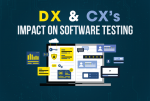Digital Transformation brings a slew of benefits for the overall business. We’ve identified 4 key benefits that we find universal to any company undergoing Digital Transformation.
Digital Transformation (DX) is happening all around us and more of them are happening all of the time. CIO made the case in 2018 that 40% of all technology spending is going towards DX projects. The past year combined with the COVID-19 pandemic has caused many organizations to speed up their DX goals, in many cases being driven by government health mandates requiring remote work and less face-to-face interaction. Many US companies have said the pandemic is a key driver in speeding up and expanding their Digital Transformation projects.
That’s certainly a compelling reason to drive DX initiatives. In this case, many organizations had no choice but to adapt and DX was a key element in that. The broader question is what happens when we return to normal, or at least a new definition of normal? Will DX projects drop off after there is less of a compelling need? Is this a “fad”?
The classic admonition of “If your friends were going to jump off the Golden Gate Bridge, would you also do it?” comes to mind––I certainly wouldn’t do it without a good reason! With that, let’s examine what some of the “good reasons” for DX would be from a business benefits perspective.
Benefit 1: Increased Productivity
Let’s be clear here, the goal of any DX project, or any technological advancement, is to receive a return on investment. The main driver is to increase productivity. That could be achieved by making sure there is less friction in respective business processes. A key way to achieve less friction could be automating the repetitive and more mind-numbing aspects of workflows and tasks, which can be done through solutions like Automated Testing, or, for processes, Robotic Process Automation (RPA) bots. By effectively streamlining or helping individuals achieve their goals with less effort, the more likely individuals will engage in those tasks and thus perform better. When you multiply that by all members of the team, the productivity improvements can be substantial.
Test Automation projects are often key beneficiaries of these improvements, especially if the Test Automation in question focuses on those tasks that are particularly repetitive and thus annoying to have to do. Even if we take the testing aspect out of the equation, just by handling the setup and configuration options of particular tasks, we can achieve immense benefits because our time and attention can be spent on much more important things, such as actually testing to see how our systems are working.

Benefit 2: Enhanced Data Collection, Data-Driven Consumer Insights
As a tester, one of my favorite phrases when asked about a particular state of things or the conditions of a situation is to ask, “What does the data say?”
Every interaction, every transaction, every comment and use is a data point. When gathered together, they can be overwhelming and not tell us much. However, with structure and rigor, we can analyze the data we receive, synthesize it, and reach conclusions based on what the data is telling us (like all good scientific inquiry).
By performing a DX project specific to analytics and interpreting the data received, it is possible to learn a lot about our customers, their preferred actions, their actual approaches and workflows, and their specific adoption of features. Additionally, we can learn which features we have worked on that are not being adopted. We can learn what platforms they are interacting with and by extension how we should be focusing our time and attention to help meet their needs. This can be extensible across many areas of Software Development. Particularly, this is a boon for looking at having hard knowledge on how to improve the product for increased customer satisfaction/loyalty. Other benefits include better planning strategy on product roadmaps, as well as allowing for businesses to invest on features that they know are being adopted, or do better education around ones that aren’t, thereby eliminating one barrier to entry.
An example of this is to examine and look at the device interactions. If we have spent a great deal of effort developing features for the desktop experience and our data analytics inform us that 70% of our interactions take place via mobile devices, that’s a key insight that can help us shape where our development initiatives should be. Perhaps there is more benefit to rolling out/releasing features specific to the mobile market in this example. Why? The data tells us so!

Benefit 3: Increased Profits & Market Share
Again, the goal of any DX project is a positive return on investment. If profits increase and market share increases, that is an excellent indication that our DX efforts are bearing fruit. If we are increasing focus on the various workflows that are essential, those interactions are able to aid us in gathering the necessary data we need, both in the important specific details of the workflow and interaction to meet the objective but also in the way that our customers are interacting with and using our systems. A benefit of this data collection and analysis is that we will have the opportunity to answer our customers’ problems more rapidly, more efficiently, and more effectively.
Studies indicate that 80% of organizations that have successfully completed DX projects report increased profit. 85% say they have increased their market share. On average, leaders expect 23% higher revenue growth than their competitors.
Source: https://www.sap.com/dmc/exp/4-ways-leaders-set-themselves-apart/index.html

Benefit 4: Overall Improved Customer Experience
Perhaps the most important question to ask when embarking on a DX project is to understand who will benefit from the transformation. While, yes, we want to reap benefits for our organizations, the key place to focus on and ensure improvement is the experience of our customers. DX projects are effectively useless if the net result is that our customers do not have the ability to do what they need to or it is not easier to accomplish the tasks they need to.
Customers are used to having endless options, a variety of prices, and to not have to “jump through hoops” to get what they want. Changes that enhance that experience will likewise be beneficial to us and changes that complicate or hinder the customer’s objectives will work against us.
Gartner reports that more than two-thirds of companies say they are competing mostly on customer experience. In 2020, they expect that number to rise to 81%. Even a single point increase in customer experience (CX) scores can result in millions of dollars in annual growth.
CX is more than just how your customers feel about using our product. It’s every interaction with the product––not just the UI. Every touch point that the customer has with the product will have an impact on their perception and impression of not only our product, but our organization. Think about every way that customers interact with us: Our help documentation, our customer service line, our delivery method and speed of that delivery (whether that be an online product or a physical product); all of that comes into play and every one of those touch points has the potential to ensure future business––or drive it away.
Let’s think of this from the perspective of the “5 star review” that has become so ubiquitous. Most people that look at this number are looking to see how close it is to that 5 mark and how many people have contributed to it. Thus, it is in our best interest to do what we can to maximize the potential for those 5 star reviews. Any glitch or misfire in the process can cause a lower review and an overall diminution of the perceived CX of our product. Put simply, CX is important because people talk and what they say can not only help with retaining their current business but also with gaining and retaining future business.
How the LogiGear Group Can Help You Realize the Benefits
LogiGear has recently invested in MK Partners to form the LogiGear Group: Your one-stop shop for your Digital Transformation needs! For over 27 years, LogiGear has brought Silicon Valley Testing Expertise to our clientele. As we approach the new era of Digital Transformation we want to be there to help you bridge that gap as seamlessly as possible.
By improving on Automated Testing, the repetitive tasks can be set up and validated, allowing more time for specific observation and learning, resulting in better overall quality. Development teams can take advantage of these changes, helping to make the iterative software development process run more smoothly, help to create a more robust and fault-tolerant pipeline for building and delivering software, and ultimately lead to the ability to deploy more frequently, allowing for more targeted feature development and release with lower overall risk. CRMs like Salesforce have many customizable features that can be developed to help speed workflows and create quicker methods to both gather information and analyze the information gathered to help make for better business decisions.
Whether you’re looking to overhaul your Software Testing program, develop custom software for your business and clients, or capture more value from your Salesforce instance, we’re here to help.
Conclusion
Digital Transformation projects that are successful often lead to a variety of positive outcomes: Workflows are streamlined and easier to interact with; performance is improved and the end-user experience is enhanced; the overall customer experience is improved and customers who feel effective and empowered become return customers, often enthusiastically. Additionally, with better data collection and analytics, we as organizations can view trends, understand issues and sticking points, and better understand how we can help our customers achieve their goals and do so in an increasingly effective manner.
At the end of the day, any DX project is meant to enhance and improve the customer experience and encourage their continued access and use. These benefits are great but it’s critical to have both a proper strategy and consider the possible pitfalls. Even with these impressive outlooks, 70% of digital transformations fail, most often due to resistance from employees. It’s critical to get everyone’s buy in and have them all be part of the process of DX, not just hope for the best.
To help ensure the best outcome, seek expert help from companies like LogiGear, who have the technical know-how and industry expertise to set your DX up for success from the start.
This article is not endorsed by, directly affiliated with, maintained, authorized, or sponsored by any of the companies mentioned in this article (CIO, Gartner). All product and company names are the registered trademarks of their original owners. The use of any trade name or trademark is for identification and reference purposes only and does not imply any association with the trademark holder or their product brand. Author’s views are not associated with LogiGear Corporation.















